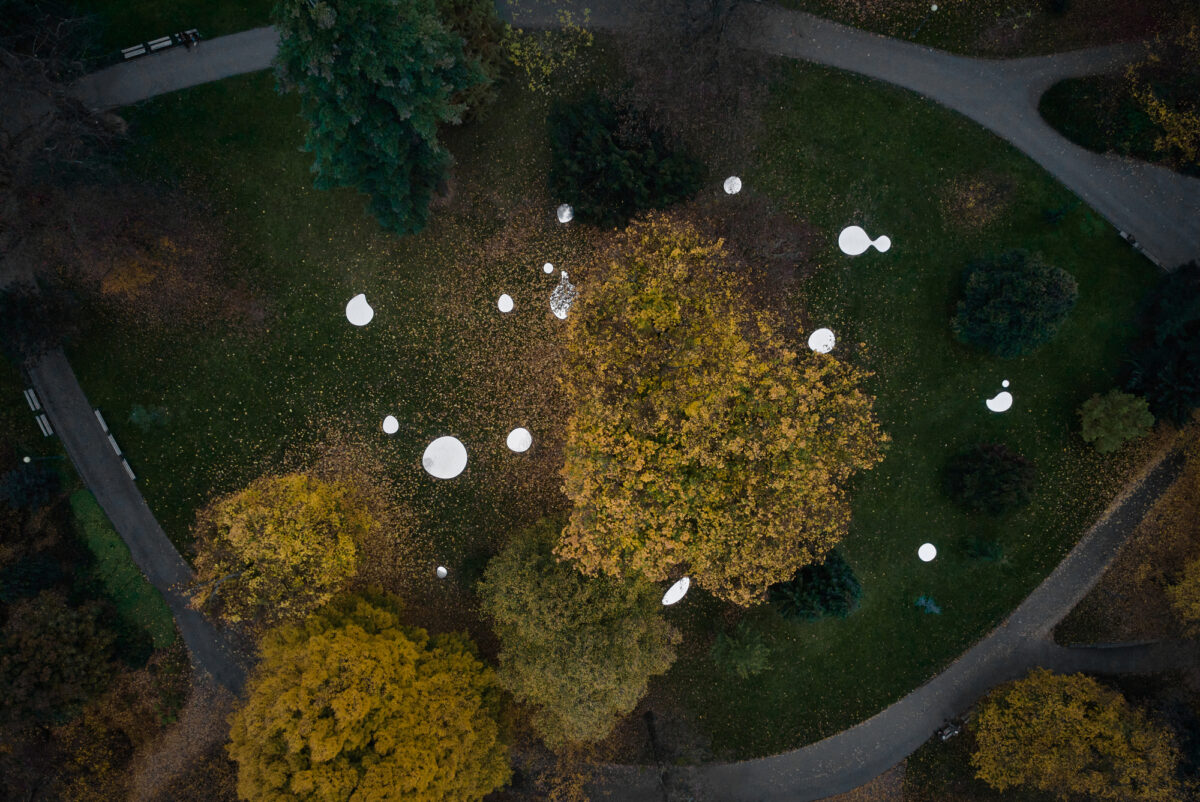Mirrors of Zlín Installation / Loom on the Moon
Text description provided by the architects. The Exhibition The Mirrors of Zlín was created for the occasion of 700 years of history of the city of Zlín, which manifested as a series of multimedia installations in the chateau park. The first of the three installations work with the distinctive perspective of writer Pavel Kosatík on the evolution of the city and its surroundings, which we subsequently complemented and summarised with illustrations.
This resulted in an intergenerational dialogue between text and image, which are sometimes in harmony and sometimes in contrast. In addition to this narrative part, there are two installations in the chateau park. One is an immersive film, an audiovisual experience that allows visitors to inhabit past moments of Zlín in various eras, seasons, lights, in rural times, during a fire, when the railway arrived, during the Bata boom, and also present moments. It is a frame-by-frame painted animation that treats each frame of the film as a painting.
The last permanent installation is the mirrors of Zlín – a lyrical constellation of fluid shapes, poetically placed among the most beautiful trees of Zlín‘s park, whose treetops, flowing sky, and curious passing visitors they reflect. The soul of this part of the installation is a sound composition that is a celebration of the cycle of time, the turning of the seasons, the lengthening and shortening of the days, the moments of equinox and solstice, which functions as an unpredictable, surprising solar calendar or astrological clock.
The basis for the music composition that sounds through the park in various phases of the year was a careful mapping and study of the sounds of bells in the belfries of the Zlín Region. Thus the park rings with the vibrations of bell bronze, which creates a scaled-down geographical imprint of the Zlín Region. The individual multi-channel musical compositions and their exact position in time and the year correspond to a study of the movement of the sun and stars. The sound level is supported with a moving light, which not only provides a visual accompaniment to the mirrors and music but also a poetic and playful alternative to the park‘s night-time lighting.
This results in a harmony between natural and artificial light, between the sound of the park, the musical composition, and the passage of time. The Mirrors of Zlín thus becomes an artwork that can exist only in this place, at this time. Materials. The exhibition is composed of three interconnected elements:
1. Encyclopedia: The Encyclopaedia is a simple wooden wall with a circular ground plan with a total length of about 40 m and a height of 3 m. Its shape adapts to the existing trees – it gives way to the eaves line of their crowns, giving the wall a dynamic form. The outer shell is made of a mirror-polished steel sheet, and the inner surface of waterproof plywood serves as a surface for the artistic representation of 700 years of Zlín’s history.
2. Immerse: The section called Immerse is essentially a simple summer cinema. The projection surface is similar in design to the Encyclopedia – the waterproof plywood skeleton is lined on both sides with plywood panels, and the inner side facing the Encyclopedia is mirrored polished steel sheet. This creates an interesting optical theatre for the audience between the two mirrored surfaces – one flat and the other rounded.
3. Statements: The last element of the exhibition consists of a group of mirrors placed on the lawn between the trees, evoking rain puddles. Even their construction is designed to be lightweight, and non-invasive. The base is designed on earth screws that anchor the Statements against being moved and toppled over. A simple thermal and moisture-insulated enclosure for the equipment will be placed above the ground surface. The “level” itself is designed as a thin plate with a polished stainless steel sheet surface. The individual elements are varied in shape and size – like real rain puddles. Inside each element, there is a speaker and lighting technology. The elements are interconnected and synchronized into an immersive installation.
